Learning motivation, small steps, and persistence are crucial elements for K12 students facing the challenge of lacking enthusiasm for learning. Many K12 students struggle with low learning motivation, which can significantly impact their academic performance and personal growth. In this article, we’ll explore effective ways to rekindle that motivation through small, manageable steps and consistent effort.

The Problem of Low Learning Motivation
Low learning motivation among K12 students is a widespread issue. There are various reasons behind it, such as heavy workloads, high – pressure exams, and lack of clear goals. For example, when students are constantly bombarded with a large amount of homework and tight deadlines, they may feel overwhelmed and lose interest in learning. As a result, they find it difficult to focus and engage in their studies. According to Education.com’s research on learning motivation, external pressures can often be a major deterrent to students’ internal motivation.
The Power of Small Steps
Taking small steps is a key strategy to overcome low learning motivation. Instead of setting big, daunting goals, students can start with something as simple as studying for ten minutes a day. This approach reduces the sense of overwhelm. For instance, a student who has been avoiding math can begin by spending just ten minutes looking over a few math problems. This small action is less intimidating and more likely to be repeated. As students gradually get used to this short study time, they can increase the duration. This concept is also supported by the incrementalism theory on Wikipedia, which emphasizes the effectiveness of making small, continuous changes.

Cultivating Persistence
Persistence is essential for turning small steps into long – term learning habits. Once students start with their short study sessions, they need to keep it up. To do this, they can create a routine. For example, setting a specific time each day for their ten – minute study. In addition, they can reward themselves for sticking to the plan. A small treat like having a favorite snack after a week of consistent ten – minute study sessions can serve as positive reinforcement. This positive feedback loop helps students stay motivated and continue their learning journey.
In conclusion, learning motivation, small steps, and persistence work hand in hand to help K12 students overcome their lack of enthusiasm for learning. By starting with small, achievable actions and maintaining consistency, students can gradually build the confidence and motivation needed to excel in their studies.
Readability guidance: Each section clearly presents its main point. Short paragraphs and simple language make it easy to understand. Transition words like ‘for example’, ‘as a result’, and ‘in addition’ are used to connect ideas smoothly.


